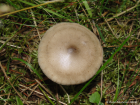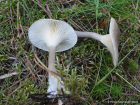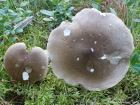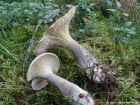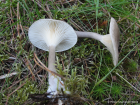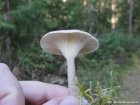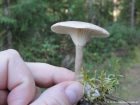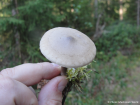Cap convex with a small boss, becoming plane to depressed in shape. It has a smooth surface. Cap colours are generally grey-brown, sometimes tinged olive, with a pale margin. Gills are strongly decurrent and cream-yellow in colour, contrasting with the rest of the mushroom. There are some smaller gills in between the regular gills, and the gills are occasionally forked near the stem. The gill edges are straight in younger mushrooms and sometimes wavy (undulate) in older ones. Flesh white, but slightly yellow at the base. Stem bulbous base, its surface is covered in silky fibres, and it is the same colour as the cap. Spore print white.
Microscopic Details: Spores are smooth, elliptical or ovoid, measuring 6-9 x 4-5µm. They are hyaline and inamyloid (not staining with iodine).
Synonyms the older name for Ampulloclitocybe clavipes is Clitocybe clavipes.
Ampulloclitocybe clavipes on the www.first-nature.com web site.
Ampulloclitocybe clavipes on the MushroomExpert.Com Web site.
Many mushrooms are poisonous, and some can be lethally toxic. Distinguishing between edible and poisonous mushrooms can be very challenging. Therefore, we strongly advise against consuming wild mushrooms. This website does not contain any information about the edibility or toxicity of mushrooms.
Although efforts have been made to ensure accuracy on this website, the information may contain errors and omissions. Therefore, all content provided is for educational and informational purposes only and should not be relied upon or used as a basis for consuming any plants or mushrooms.
External links are provided for reference only. We do not endorse or take responsibility for the content, advice, or products found on these sites or in any advertisements shown on this website.
